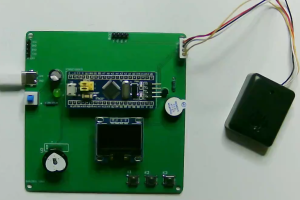设计说明书
总字数:15000+
脉搏作为人们最为常见的一种生理现象,经常用来反应人们的心脏或者血管的状态,通过脉搏可以为医护人员提供对血压及其血流等生理检测的依据。当前对脉搏的检测方法和数量都较多,当前很多都是通过医院的医护人员负责的,通过按时到病房进行人工检测,然后将检测的结果记录下来,然后工作人员通过测量的数据绘制表图,根据这些表图对病人的身体健康进行判定。但是采用这种方式进行测量需要花费的时间较多,会使得医生无法及时快速根据病人的情况进行治疗,将可能导致病人错过最佳治疗时间。而采用人工进行脉搏的检测,通常需要花费的时间为10分钟内,且经常会出现记录记录出错等问题,所以对传统脉搏进行改进,可以提高脉搏的检测速度及其检测的精度。此次设计的这款基于单片机脉搏的检测系统,该系统采用STM32单片机作为主控芯片,通过脉搏检测模块并将检测的脉搏显示在液晶显示屏OLED上,并语音播报当前监测的情况。该设备操作检测较为简单,用户也可以进行自我检测,所以此次设计具有一定的研究价值和实际意义。
关键词:脉搏监测;语音播报;OLED显示;STM32单片机
As one of the most common physiological phenomena, pulse is often used to reflect the state of people’s heart or blood vessels. Through pulse, medical personnel can provide the basis for physiological detection of blood pressure and blood flow. At present, there are many methods and quantities of pulse detection. At present, many of them are responsible by the medical staff of the hospital, who go to the ward on time for manual detection, and then record the detection results. Then the staff draw tables through the measured data, and determine the patient’s health according to these tables. However, it takes a lot of time to measure in this way, which will make doctors unable to timely and quickly treat patients according to their conditions, and may cause patients to miss the optimal treatment time. The artificial pulse detection usually takes 10 minutes, and there are often problems such as recording errors, so the improvement of the traditional pulse, can improve the pulse detection speed and detection accuracy.The design of this pulse detection system based on single chip microcomputer, the system uses STM32 single chip microcomputer as the main control chip, pulse detection module and the detected pulse displayed on the LCD OLED, and voice broadcast the current monitoring situation. The operation and detection of the equipment is relatively simple, and users can also conduct self-detection, so the design has a certain research value and practical significance.
Key words: pulse monitoring; Voice broadcast; OLED display; STM32 single chip microcomputer
目 录
摘 要
ABSTRACT
1 绪论
1.1 选题背景及实际意义
1.2 国内外发展历程
1.2.1 国外发展现状与趋势
1.2.2 国内发展现状与趋势
1.3 脉搏信号的特性和分析方法
1.3.1 脉搏信号的基本特性
1.3.2 脉搏信号的分析分法
1.4 本论文研究目标与框架
2 系统设计方案
2.1 主要元器件选择
2.1.1 主控芯片选择
2.1.2 显示模块方案选择
2.1.3 语音播报模块方案选择
2.1.4 按键模块方案选择
2.2 整体设计方案
3 硬件设计
3.1 主控电路模块
3.2 脉搏检测电路模块
3.3 OLED显示电路模块
3.4 语音播报电路模块
3.5 蜂鸣器报警提醒电路模块
3.6 独立按键电路模块
4 系统程序设计
4.1 编程软件介绍
4.2 系统主流程设计
4.3 独立按键
4.4 OLED显示流程设计
5 实物制作与调试过程
5.1 电路焊接总图
5.2 上电运行检测实物测试
5.4 脉搏监测物测试
6 结论和未来展望
6.1结论
6.2 未来展望
致 谢
参考文献
附录A:原理图
附录B: PCB
附录C:主程序
购买后可查看具体内容!

